This is a Seagull 203, a medium format rangefinder camera made by the Shanghai Camera Factory in Shanghai, China starting in 1964. The Seagull 203 is very similar to, but not an exact copy of the AGFA Super Isolette, featuring many of that camera’s features, but adding a film advance lever, an exposure calculator, dual 6×6 and 4.5×6 format exposures, and different cosmetics. The Seagull 203 was sold under a variety of different names and was produced for a long time, with a replacement model called the Seagull 203-I featuring a flash hot shoe.
Film Type: 120 Roll Film (twelve 6cm x 6cm or sixteen 4.5cm x 6m exposures per roll)
Lens: 75mm f/3.5 Haiou S-111-2 coated 3-elements in 3-groups
Focus: 1.2 meters to Infinity
Viewfinder: Combined Coincident Image Coupled Rangefinder
Shutter: Unknown Leaf (Deckel Compur copy)
Speeds: B, 1 – 1/300 seconds
Exposure Meter: None
Battery: None
Flash Mount: PC port M and X Flash Sync
Other Features: Self Timer, Folding Baffles for 4.5cm x 6cm images
Weight: 698 grams
Manual: https://www.cameramanuals.org/pdf_files/seagull_203_single.pdf
How these ratings work |
The Seagull 203 is solid copy of one of many 6×6 folding cameras produced in the United States, Germany, and Japan over the years. With a film advance lever instead of a knob and integrated support for 4.5×6 images without a removable baffle, the Seagull is a solid competitor in this segment. Although this copy of the camera had some conditional issues, I was able to get nice images from it. If you are looking to get into medium format and want an easy to use camera with a compelling feature set, the Seagull 203 is a great option. | ||||||
| Images | Handling | Features | Viewfinder | Feel & Beauty | History | Age | |
| 2 | 1 | 2 | 2 | 1 | 1 | 20% | |
| Bonus | none | ||||||
| Final Score | 10.8 | ||||||
Prologue
The history of the Chinese camera industry is perhaps the most evasive topic I’ve yet written about on this site. When researching most cameras, there is usually already a wealth of information online, and my goal with these reviews is to piece it all together into a nice and neat article with everything I could find. Even for models where not much is written, there’s usually something about the factory that made it, or the country it came from I can use to supplement what little is known about it.
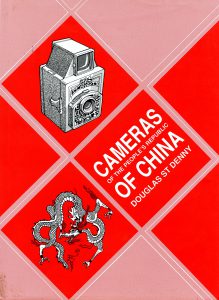
For Chinese cameras however, discovering more than a couple paragraphs on camera-wiki or camerapedia has been a challenge as there is no central chinesecamera.com website I can do to, or any dedicated Chinese camera collectors I can reach out to further understand it’s history.
When I started working on this article, I knew I would struggle with any meaningful history, so I went old school and bought a book called “Cameras of the People’s Republic of China” by Douglas St Denny. In that book’s prologue, a brief intro describes much of the same challenge I’ve encountered learning about the history of the Chinese camera industry. In a country with a long history of revolution, upheaval, and instability has resulted in a lot of information either lost, or not willing to be shared with outsiders.
In his book, first published in 1989, Douglas St Denny writes what was then, the only authoritative look into Chinese cameras. Despite his book being over 30 years old, it is still one of the best resources for information today, and the source for much of my article.
As I always do when I cite someone else’s work, I will not plagiarize St Denny, but rather summarize some of the things he says in his article for the 2021 reader, but if you are looking for more than what I’ve typed below, I encourage you to seek out a copy of the book for yourself.
History
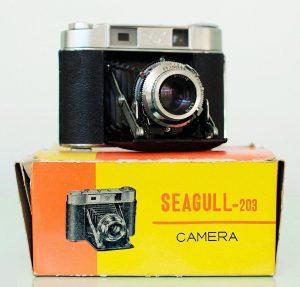 Photography in China dates back about as far as it does for the rest of the world. Around the same time Niépce, Talbot, and Daguerre were coming up with the earliest formats of photography, there were those in China doing the same thing.
Photography in China dates back about as far as it does for the rest of the world. Around the same time Niépce, Talbot, and Daguerre were coming up with the earliest formats of photography, there were those in China doing the same thing.
Early Chinese pioneers like Zou Boqi and Qi Ying made claims of being the first Chinese photographers and that in 1844 had invented photography. In the mid 1800s, Qi Ying, who was a government official, gave portraits of himself to visitors from other western countries, one of which was discovered in 1968. The identity of Ying in the photo and it’s age date it to the correct period, but how exactly the image was captured is not as clear. Whether it is evidence of a Chinese photographic process from the mid 19th century, or whether it was simply taken with a camera of European or American design is unknown.
In the late 1800s, as it did in other areas of the world, photography in China became a favorite hobby of the wealthy, as the supplies to not only acquire the equipment to make images, and the chemicals to expose and develop the images was very expensive. Most of the cameras used at this time were imported models from Europe and the United States. It is plausible that some local craftsmen may have taken inspiration from these imported cameras and made their own copies, but evidence of Chinese made cameras from this era has never been found.
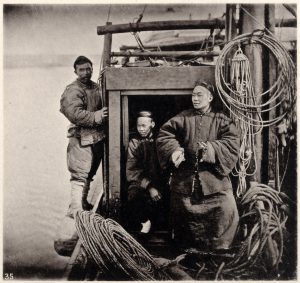
Also at this time, many Chinese photographers were employed by the government to make photos of the construction of buildings, rail lines, roads and mines so that the emperor could see the country’s progress. Most known images of the Chinese people and other scenes of every day life in China were taken by foreign visitors and not by the Chinese themselves. The 1873 book, “Illustrations of China and it’s People” was published by British photographer John Thompson and is one of the earliest known looks at what life was like in China.
After the 1911 Xinhai Revolution, which ended the last imperial dynasty in China and marked the birth of the Republic of China, modern day luxuries like photography became more well known to the Chinese people. As the years passed, imported goods from Europe and the Americas were less expensive and more attainable, signaling a rise in popularity for photography. Established companies like Leitz, Zeiss, and Kodak opened regional offices in China and imported cameras and lenses became easier to find.
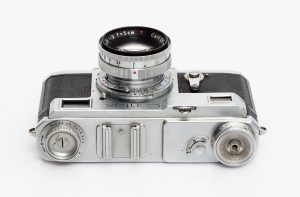
To accommodate the increased demand in the country, some companies like Zeiss produced cameras marked “For China” that were intended to be sold there. In the 1930s, the rise of Japan’s camera industry and their occupation in China during the Sino-Japanese War from 1937 to 1945 brought a huge number of Japanese cameras to the country. In the years that would follow World War II, it was not uncommon to come across many of these German and Japanese cameras in second hand shops as a huge number of them were abandoned by their original owners and wound up as resources for the decimated Chinese economy to rebuild itself with. According to Douglas St Denny, in the 1970s, prewar Super Ikontas, Leicas, and some Canon rangefinders were easy to find for sale cheaply.
Almost immediately after World War II, the Soviet Union and other Eastern bloc countries took an interest in China and had a lot of influence on the Chinese photography industry. Chinese engineers and craftsmen traveled to the Soviet Union and Czechoslovakia to study their manufacturing processes.
The earliest photographic goods sold in postwar China were Soviet imports like the Zorki and Lubitel which themselves were copies of Leicas and Voigtländer Brillants. Very little was actually produced in China, but after the rise of communism in 1949, a rudimentary Chinese camera industry was established closely resembling the Soviet system of separate factories all operating under a coordinated effort by the government.
The relationship between the Soviet Union and China which helped to form the Chinese photography industry is quite long, and has been documented in a three part series published on Kosmo Foto, which I recommend you read at the link below.
The first such factory was formed either in late 1949 or early 1950 in Beijing and was eventually called the Da Lai Precision Machine Shop. The name “Da Lai” loosely translates to “very popular” suggesting a level of propaganda in an effort to establish itself as a market leader.

Da Lai’s first products, like many burgeoning photographic operations was making tripods and other photographic goods. It wouldn’t be until 1955 or 1956 when the first Da Lai 35mm camera was made, which was a Chinese copy of the Zorki rangefinder. The Chinese factory built the camera body, shutter, and housing for the lenses in Beijing, but lacked the ability to produce glass lenses, so those produced for the Zorki were used. Since the Da Lai 35mm camera was built to exact Soviet specifications, swapping lens elements was not a challenge. It is thought that a total of 12 of these Da Lai 35mm cameras were produced, only one of which is known to exist today in the museum of the current day Beijing Camera Factory.
A coordinated announcement of the release of China’s first camera was made on August 4, 1956 in a variety of Chinese publications. The announcement included photographers of Chinese workers assembling the cameras, sample photos said to be made by the cameras, and a large amount of praise for the camera’s high quality.
Around the same time as the development of the Da Lai 35mm camera, a second camera which was a copy of a Japanese Ricoh TLR was being worked on but never finished. Despite receiving a huge amount of support by the Soviet Union, the Republic of China was going through a period of great instability. The Da Lai Precision Machine Shop was both privately and state owned, which caused there to be a huge amount of worker turnover. Shortly after the release of the Da Lai 35mm camera, the Chinese government assumed complete control over the factory and renamed it to the Beijing Camera Factory, the name it still uses today.
The first camera produced by the nationalized Beijing Camera Factory was made around 1957 and was called the Rainbow, which looked very much like the Dai Lai TLR prototype created earlier.
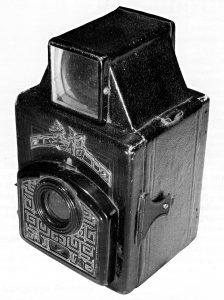
Around this time, several other Chinese optical factories would be opened in Shanghai, Nanjing, and Tianjin. In the case of Shanghai, at least five different factories would open, all with generic names like Shanghai Factory Nos. 1, 2, and 3. As best as I can tell, these factories were operated similarly to how Soviet factories were operated in that the communist government had a lot of say in what went on in each company. The Chinese economy did not function like those in capitalist countries like the United States, in which independent companies research and produce models, competing for the buying dollar of the general public.
In the years that would follow, a huge number of varying camera designs, all inspired by existing models from Japan, Germany, Czechoslovakia, and even Poland were made in Beijing. Models with names such as Tian Tan (Temple of Heaven), Yuejin (Leap Forward), and Xing Guang (Star Light) were produced in unknown numbers and were of simple design because they were cheap and easy to produce, unlike the Zorki based Da Lai 35mm camera which required a much higher level of mechanical precision.
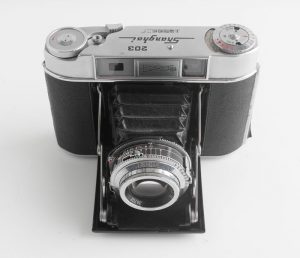
In 1963, a new model built in Shanghai at Shanghai Factory No. 2 called the Shanghai 203 was released. The Shanghai 203 was a fairly advanced medium format folding camera that shot 6cm x 6cm images on 120 roll film. The camera was very similar to, but not a direct copy of the AGFA Super Isolette, and featured a coupled coincident image rangefinder, a film advance lever, double exposure prevention, a nine-speed leaf shutter, and a good 75mm triplet lens. The Shanghai 203 was only produced for one year when it was mysteriously renamed the Seagull 203 in 1964. Other than the name the two cameras were identical.
In 1966 the Chinese Cultural Revolution began which was a political movement to preserve Chinese communism by purging remnants of capitalist and traditional elements from Chinese society. During this period constant struggles happened throughout the country between people with different ideals in which people would be imprisoned without cause and anything thought to have a Western influence was destroyed. During this time, many cameras of European design were likely destroyed. While no evidence of this exists, it was likely this revolution why so much of the history and existence of early Chinese cameras like the Da Lai 35mm camera no longer exist. For those who survived this period, talk of anything pre revolution was discouraged and could even result in heavy penalties, so during Douglas St Denny’s research for his book, it was very difficult for him to find people willing to talk about this period.
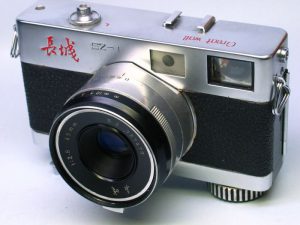
A camera being developed around this time which was a copy of a 35mm clockwork drive Ricoh model was initially called the Beijing SZ-1 but due to concerns that cameras built in one factory would not appeal those living in other territories, the camera was renamed the Great Wall SZ-1. The use of the name “Great Wall” was very common in many Chinese products including cameras. At least thirteen different cameras of completely different designs are known to exist all referred to as the Great Wall. It is this reason that perhaps explains why the Shanghai 203 was suddenly renamed the Seagull 203, to eliminate any association from where it was built from it’s name.
The Seagull 203 was produced for a little over ten years, being replaced by a similar, but identically named model in 1975. It is one of the most common Chinese cameras from this period to find today. No records were kept of how many were made, but as I write this, nine are for sale on eBay suggesting that at least a good number were made for it to be that easy to find today.
According to Douglas St Denny’s book, when it was new, the Seagull 203 cost 100 RMB Yuan, which is approximately a one month’s salary for a university professor. This means that the camera was likely out of reach for the common worker, but you also didn’t need to be extremely wealthy to afford one either.
The second version of the Seagull 203 was also produced for about ten years and differs from the original in that it now includes an accessory shoe on the top plate, a plastic tipped film advance lever, and loses the EV coupling on the shutter.
Two variants of the second version of the Seagull 203 exist, one which was black and had a regular accessory shoe was called the Seagull 203-H, and a second version which only came in chrome but replaced the accessory shoe with a flash hot shoe was called the Seagull 203-I.
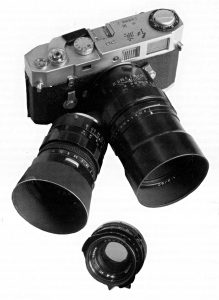
Throughout the rest of the 20th century, some of the most ambitious Chinese cameras were made at one of the Shanghai factories. Copies of the Leica III (Shanghai 58-I and II), Leica M4 (Hong Qi 20), Hasselblad 500 C (Dong Feng), Rolleiflex (Seagull 4A), and various Minolta SLRs (Seagull DF-1) were all made with varying levels of success.
In 1978, Shanghai Factories number 1, 2, and 5 merged together (I do not know what happened to numbers 3, and 4) to create the Shanghai General Camera Factory, which was a new 130,000 square meter building, 50 kilometers outside of Shanghai. This factory is still in existence today and according to this website, claims to be China’s largest manufacturer of cameras and photographic accessories.
It is clear that the Chinese camera industry is rich in history and likely is full of interesting stories and models, but sadly, due to political and cultural obstacles, much of the true history has been lost.
Although Douglas St. Denny’s book has a lot of great information, I can’t help but feel that it only scratches the surface of how it all happened. Earlier in this article, I brought up the the connection with the Soviet Union which likely helped advance the Chinese camera industry much faster than it otherwise would, but understanding the complete Soviet/Chinese connection is likely beyond the knowledge of any one person.
Today, there is very little to go on when it comes to Chinese cameras. Not helping matters are the huge numbers of knock off “Scameras” and “Trashcams” that tarnish the reputation of the Chinese camera industry.
I’m not suggesting that one good experience with one camera invalidates the overall opinion of an entire industry, but at the very least, with cameras like the Seagull 203, it’s worth knowing that there are some examples worth seeking out. I very much like this camera and am optimistic about it’s use, so keep reading to see how that turned out!
My Thoughts
There’s a saying “penny wise, pound foolish” that describes someone who is good at minimizing expenses by making small cuts here and there in an effort to save money, but in doing so, ends up spending a lot more money on more expensive things. Such is the case of my 2019 trip to a camera show in Cincinnati, Ohio where I saw a nice looking Seagull 203 sitting there on a table. The camera had a price tag of $30 on it, but the seller was wheeling and dealing and I probably could have picked it up for $20, but decided, “naaah, I don’t need one of those”.
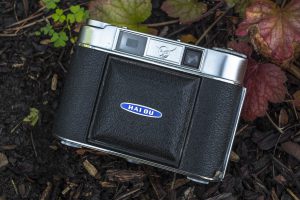
That decision would prove to haunt me as after I left that show, I kept thinking about that Seagull, kicking myself for not picking it up for such a reasonable price. As these things happen, I added the camera to my radar, looking for one in good condition for a good price. I ended up getting lucky in finding this one for close the price of that first one, but after paying tax and shipping, I could have saved myself some “pounds” by buying the first one I saw.
Many sources online suggest that the Seagull 203 is based on, or even a copy of the AGFA Super Isolette, but other than shooting 6×6 images on 120 film and having a leaf shutter and a rangefinder, the two cameras share little in common. Compared to other 6×6 folding rangefinders I’ve handled like the Super Fujica-6 and the Suzuki Press Van, the Seagull doesn’t quite have the same quality feel and although I have never come across a Super Isolette, it’s reputation suggests that it would feel superior to this camera as well. A more fair comparison of build quality would be to the KMZ Iskra, which has quite a bit of heft, but feels a little clunky. That’s not to say the Seagull 203 feels like a cheap camera, it’s actually quite nice, just not up to German and Japanese standards of the era.
The chrome finish on mine is shinier than most other chrome plated cameras, similar to the Voigtländer Bessamatic, but on mine shows random areas where the chrome is pitting, suggesting either a thinner coat, or less refined plating methods.
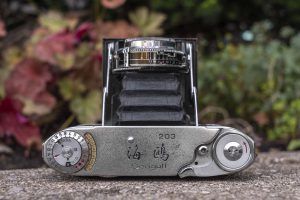
The top of the camera starts on the left with a combined film reminder dial and exposure calculator. The Seagull 203 does not have a meter, so these things are here just to act as reminders and a guide for measuring exposure with a hand held meter. ASA and DIN speeds from 12 to 800 and 12 to 30 can be chosen as can EV numbers from 4 through 17 using a combination of red symbols on the top and some pointed Chinese characters under a plastic window on the top plate. Although I cannot read Chinese, the calculator likely works similar to other Sunny 16 style exposure calculators found on other unmetered cameras.
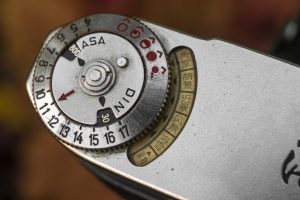
There is no accessory shoe on the camera, instead in the center is a front door release button and an engraved Seagull 203 logo and some Chinese characters. Off to the right is the film advance knob and cable threaded shutter release button. The Seagull 203 does have a primitive form of double exposure prevention, which locks the shutter release until you advance the lever, but the lock is released with only a small motion of the film advance, so you must pay close attention to the exposure numbers seen through the red window on the back door.
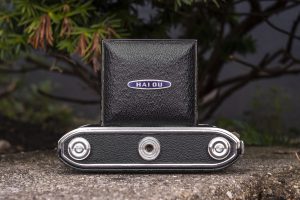
On the bottom of the camera are two small feet which can be pulled down when loading film to release the spool, making loading in new film easier, and a centrally located 1/4″ tripod socket. The presence of a 1/4″ socket when some European and Soviet cameras were still using 3/8″ sockets suggested this camera was intended to be exported out west.
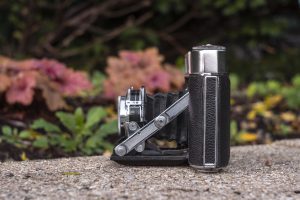
The camera’s left side has the door release for the right hinged film door, and nothing else. From this side of the camera, you also get a look at the side of the shutter with the flash sync port, and the control lever for the coupled EV scale.
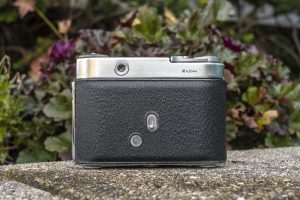
Around back, we see the round opening for the combined viewfinder and rangefinder window, an engraving for the serial number, and on the door itself, two windows, one for twelve 6×6 exposures, and another for sixteen 4.5×6 exposures. A single slider opens both windows at the same time, revealing the exposure numbers for 6×6 and 4.5×6 numbers.
With the door open, we get a look at the Seagull 203’s film compartment, which reveals my favorite feature of the camera which is the folding flaps for shooting 4.5×6 images. Although many 6×6 and 6×9 cameras supported multiple formats, they almost always require the use of a removable mask which can often get lost. With the Seagull 203, this is avoided by simply putting a hinge on the left and right side masks. For the smaller 4.5x 6 images, you keep the masks folded over the film gate and thread a new roll of film over them, for 6×6, fold the masks down inside the spool compartment. You’ll need to remove the spools to fold the masks down, but once they’re out of the way, the camera works like any other 6×6 camera.
Changing between formats is not possible with film in the camera, but being able to choose which size images you want each time you load in a new roll, without having to remember where you put the mask is a great feature that I wish other companies had thought of.
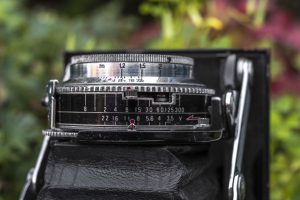
The Seagull’s leaf shutter is a Chinese design that is clearly based off some other rim set German Compur or Prontor shutter. From the top, you can see both a shutter speed and aperture scale with a red dot and a red tipped pointer indicating which is selected. The Seagull 203 uses a coupled EV scale which requires you to press in on a little lever off to the left to “break” the coupling between shutter speeds and f/stops. If the dual format masks in the film compartment are my favorite feature of the camera, this coupling is my least favorite. I don’t like these coupled scales on metered cameras, but to have to deal with them on an unmetered one is extra frustrating.
The Seagull 203 has a front cell focus which can be changed by a knurled ring located behind the shutter, or by rotating the front element directly. Focusing the lens is coupled to the rangefinder, so you can easily achieve sharp images from 1.2 meters to infinity.
A green tipped lever in front of the shutter speed scale is the shutter cocking lever which must be done before each image, and a red tipped lever to the right of the aperture scale is the self-timer. As with most mechanical cameras of this era, unless you are certain the camera has recently been serviced, I advise against trying to use the self-timer as it will likely seize up the shutter.

The Seagull 203’s viewfinder is large and bright, with a yellow tinted rangefinder patch and two projected yellow lines for framing 4.5×6 images. When framing 6×6, you use the whole viewfinder, but for 4.5×6, you only use what falls between the yellow lines. The main part of the viewfinder has a bluish tint to it, which helps boost contrast with the rectangular rangefinder patch. The one on this example still had a lot of contrast, making focusing in less than ideal light very easy. There is no parallax correction, or even parallax marks to help compensate at close focus however, so you should be mindful of this with closeups.
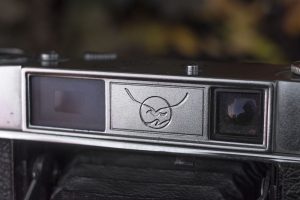
The overall first impression I got from the Seagull 203 was that of a well built camera with some thoughtful upgrades from that of a more basic model. The chrome plating was shiny and appeared to be high quality and although the focus was a bit stiff, it wasn’t anything I hadn’t experienced with other Japanese or German models of the same era. If it weren’t for the name and the Chinese characters on the top plate, you would be forgiven if you didn’t even realize this camera was made in China as it is quite a bit nicer than later “Scameras” that other Chinese companies would be known for later in the 20th century.
After handling the camera for a short time and dry firing it a few dozen times, I was optimistic about it’s use and couldn’t wait until I had a chance to load in some film and take it out shooting.
My Results
For the first roll through the Seagull 203, it probably would have made sense to shoot some Seagull film, but I wasn’t on my game that day, so I chose some Fomapan 100. Foma is a good general purpose black and white film with enough latitude to accommodate exposure variances, making it a perfect film for testing new cameras. I used the mask for 4.5×6 images since I’m not only a big fan of this aspect ratio, but I also wanted to test out this feature, plus, you get four extra images to look at!
When the first roll from the Seagull 203 came out of the Paterson tank, I could see most of an entire roll of properly exposed images. I say mostly, as there were a few blank exposures, which could be the result of me double advancing the film, or the shutter not firing on a few. To be honest, I didn’t pay a lot of attention to the shots I was taking, so off the top of my head, I couldn’t remember any shots I made that weren’t there, so I assumed that I just had a brain fart and double advanced the film. I guess that’s better than double exposing two images!

Sharpness from the Haiou S-111-2 lens is as good as you’d expect from a medium format triplet, with excellent sharpness in the middle and some softening near the edges. Vignetting was very mild, even in images where the sky is present, suggesting the lens has good coverage for both 4.5cm and 6cm images.
In the 1960s, I imagine the typical customer for a Chinese 6×6 folding camera was someone who either couldn’t afford something better, or perhaps lived in an area where they weren’t able to find anything else. China is, and always has been a little restrictive when it comes to imported goods, so it’s plausible for someone in China, or other communist friendly countries, this was the best you could get, and for that, it does a pretty good job.
In terms of image quality and use, the Seagull 203 compares favorably to a huge number of low to mid range German, Japanese, Soviet, and American 6×6 folders. The 3-element lens is good enough for most people, but certainly won’t wow anyone looking for “the next best thing”. The viewfinder and rangefinder are decently large and bright, the body’s chrome plating is nice, although a little thin, and the ergonomics are on par with other similar cameras. Without a doubt, my favorite feature of the camera are the twin folding doors in the film compartment that let you select between 6×6 or 4.5×6 images. Having hinged doors, rather than a removable baffle like other makers did, eliminates the very likely chance the baffles would get lost.
Where the Seagull 203 falls a little short is in execution. While seeing a film advance lever on a 6×6 folder is interesting, it functions exactly like a knob in that it unlocks the double exposure prevention and turns the take up spool, but nothing more. On my example, winding the film felt very loose, unlike German cameras which give you a sense of connectedness with the film inside. Winding the lever doesn’t cock the shutter, there’s no automatic exposure counter, and there’s nothing suggesting you’re using anything more than a knob with a handle sticking out of it. While the leaf shutter worked as you’d expected, it was a little disappointing for a camera made in the 1960s that continued through to the 1980s, to still rely in the tiny levers and rings typically found on leaf shutter cameras from a decade or two before.
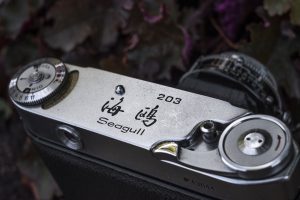
Overall, the Seagull 203 is an attractive and reasonably well built camera with a couple of cool features, but that wasn’t enough for me to shake a sense of ambivalence I had towards it. I intended to shoot a second roll of film through this camera before reviewing it, but every time I contemplated loading it up, I struggled to actually do so. I didn’t hate the camera, I just couldn’t push myself to use up one of my depleting stocks of 120 film.
I talk to a lot of other bloggers who review cameras and many of them have the belief that you need to shoot 10 or more rolls of film through a camera over the course of months to truly get to know the camera’s strengths and weaknesses. I suppose for a truly detailed review for the person intending to make this their regular camera, I’d probably want to hear thoughts from someone who shot more than a single roll through it too, but in my defense, when you review as many cameras as I do, it’s not hard to know after a single roll which cameras speak to you, and this one didn’t.
The Seagull 203 is not a bad camera, and in some ways, I think its very cool that the Chinese camera industry was mature enough in 1964 to even come close to many other similar cameras, but therein lies my summary of the camera. The Shanghai Camera Factory aimed low with the Seagull 203 and they succeeded!
Related Posts You Might Enjoy
External Links
http://camera-wiki.org/wiki/Seagull_203
http://web.archive.org/web/20150228173333/https://www.thorleyphotographics.com/?page_id=81
https://www.120folder.com/seagull_203.htm
https://www.photrio.com/forum/threads/seagull-203-6×6-a-great-daily-user.99270/
https://www.photo.net/discuss/threads/re-animated-seagull-203.5500020/
https://kosmofoto.com/2020/12/soviet-chinese-camera-collaboration-the-birth-of-a-giant/

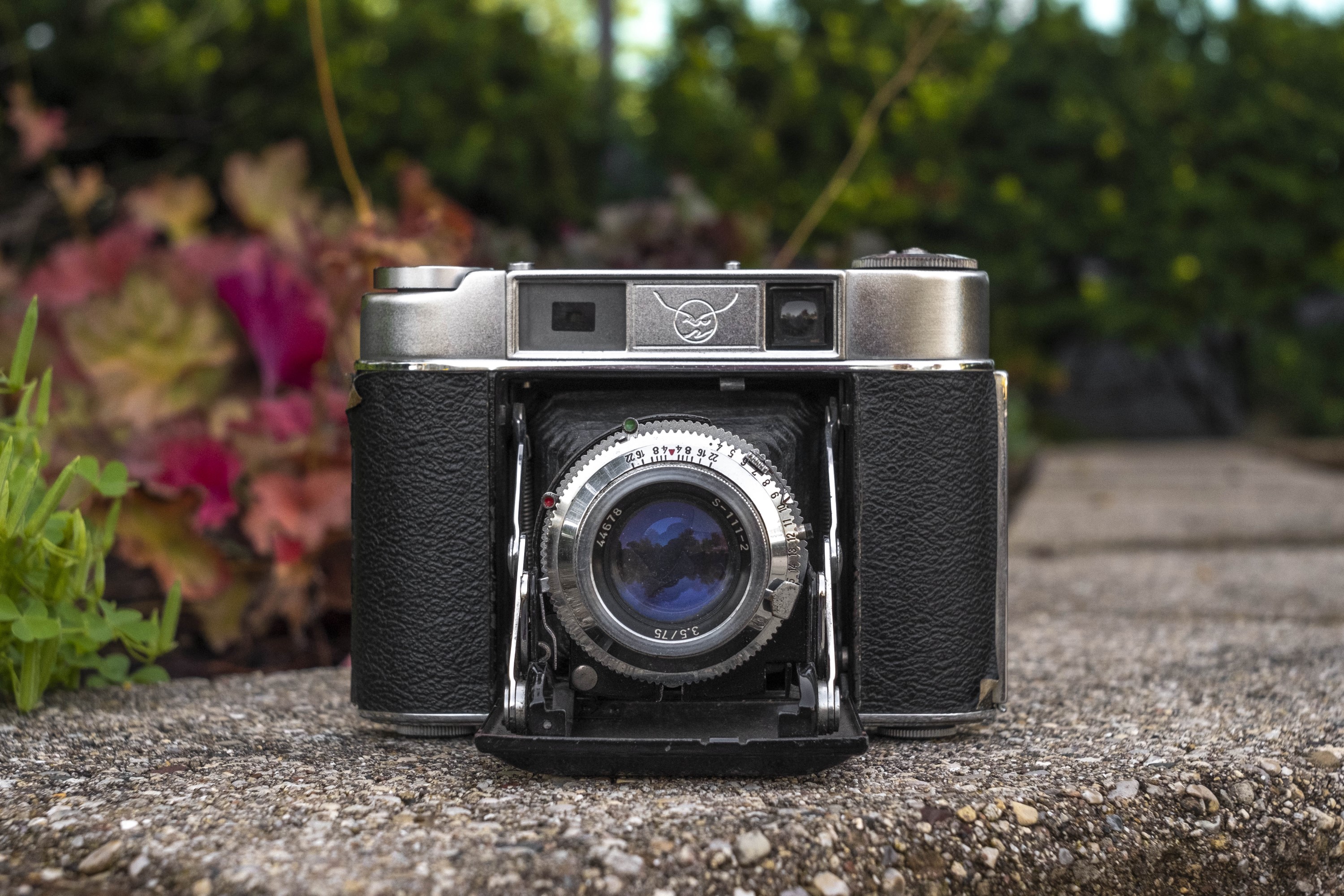
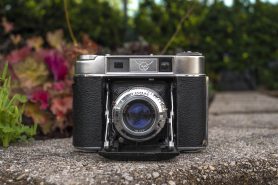
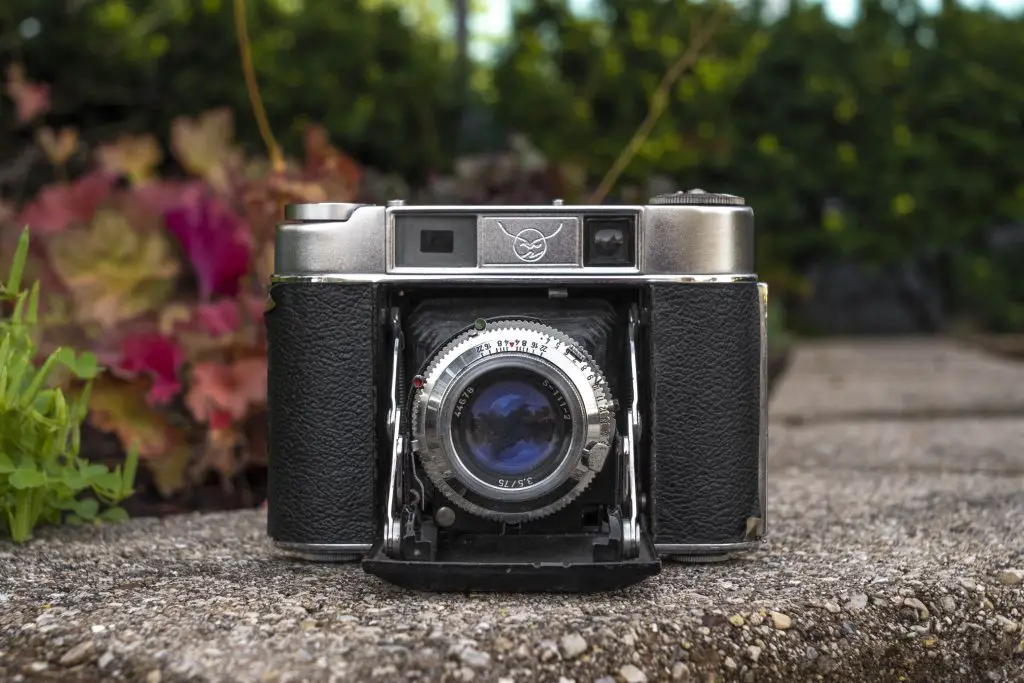
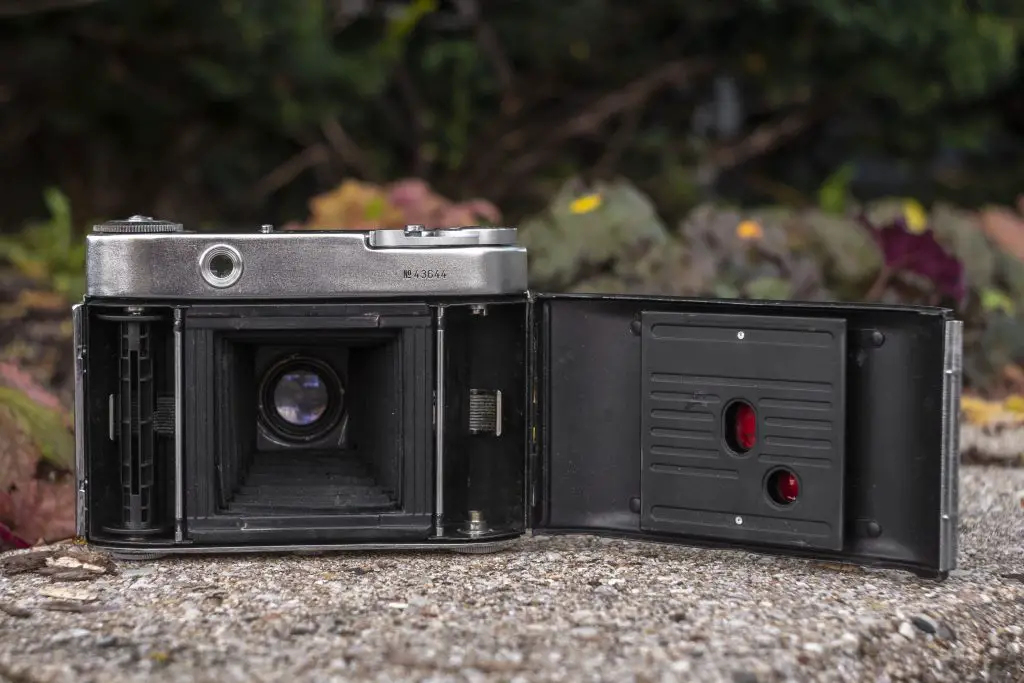
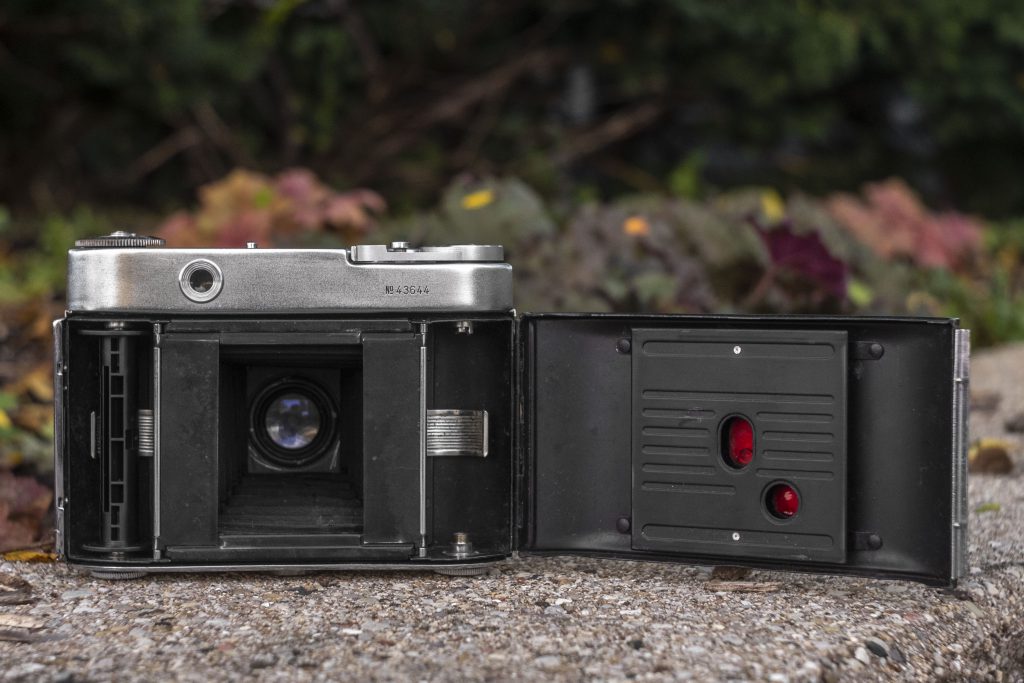










The film advance lever was probably copied from the Dacora Royal RF made in 1955, and yes obviously there are similarities to the Soviet Iskra. Be good to do a side by side comparison as the Iskra is on my list of 120 folders to review.
Nice write up, it’s interesting to read a little of the history of Chinese camera manufacturing, a topic that doesn’t have a great deal of coverage on english language websites. The one thing I would say is that the Seagull 203 seems to me to be much more based on the Zeiss Super Ikonta III & IV (531/16 and 534/16) than the Agfa Super Isolette. The focus ring an the way it couples to the front cell and the rangefinder mechanism is the same as those Super Ikonta models
I’m Chinese, and what I can tell you is that the Chinese characters on the combined film reminder dial is (亮室)the room with high luminosity,(阴景)the scene with some shadows, (近景)the scene that close to you, (风景)landscape, (海雪) sea and the snow. I hope this is helpful to you.
Excellent! Thank you for the translation, Wang! 🙂
I had 2 of these models that Fell Apart on me, One was that the lens shutter plane just came OFF, and it was a PAIN in figuring in replacing back. Then I got a second one model that the shutter JAMMED on me, and the Focusing Cam disconnected, I had enough of this model 203, and that I decided to get a Plaubel 6×9, and the Zeiss Ikonta 2.8, in which i was happy to receive them that both models date from 1933 to 1938, and was very please with the results…
“I have never come across a Super Isolette, it’s reputation suggests that it would feel superior to this camera as well.” Bingo. I have the Ansco version of the Super Isolette. It’s another universe of build quality. That said, I kinda like the rough edges of the seagull. I’m always afraid of breaking my Super Isolette when I’m out. I don’t think I’ll worry too much about the Seagull.
You make a good point in that sometimes a “lesser” camera is more ideal to being used as they’re not as valuable. I am far more likely to take out an Argus C3 than I am a Leica M3 due to it’s value.